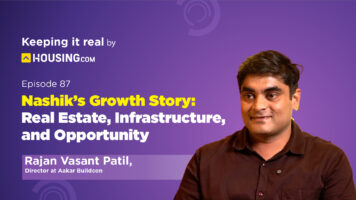Prestressed concrete is a type of concrete in which an initial compression is given to the concrete before applying the external load to balance stress from external loads in a desirable way during the service term. Tendons, made of high-strength steel, are embedded in the concrete to provide this initial compression. Prestressed concrete is a system in which stresses are purposefully introduced without external loads to increase functionality. When an external load is applied to a concrete structure, the outer tensions are balanced by the internal pressures of the structure.
Prestressed concrete: Concept
The working of prestressed concrete can be understood with an example of a barrel. Metal bands snugly encircle a barrel, a container used in the past to transport liquids and grains. There is a hoop-like compression around the barrel from the metal bands. Hoop tension is created when this barrel is filled with its contents. The compression of the metal bands around the container counteracts the strain of the material inside the barrel. These components are part of a prestressing system. Similarly, tensioned steel bars create effective internal stresses into the concrete before any service loads are applied to the concrete structure. This tension balances off other, more extreme stressors.
Prestressed concrete: Purpose
While it holds together well under pressure, tension is where concrete struggles. Because of this vulnerability, concrete flexural elements like beams and slabs tend to break prematurely. The tensile stress the structure experiences while in use is mitigated by intentionally inducing compressive stress in the concrete. As a result, flexural cracks are less likely to appear. The pre-compression created during prestressing improves the flexural members’ bending, shear, and torsional capacities.
Prestressed concrete: Application
Stability-inducing compressive stresses in prestressed concrete may be imposed before or after the material has been set. Pre-tensioning is a technique that involves stretching steel before pouring concrete. It entails installing steel tendons between two abutments and stretching them to around 80% of their capacity. The concrete is then poured into the moulds and allowed to cure. After the concrete has reached the desired strength, the reinforcement may be removed. Some of its applications are:
Bridges
Prestressed concrete box girder bridges are the most prevalent use when the concrete is prestressed at a factory before being delivered to the bridge site. Long-span bridges often utilise this kind of bridge because of its strength and durability.
Storage tanks
Prestressed concrete tanks benefit from being built to withstand the pressure of the tank’s contents. It allows for a thinner and lighter wall, resulting in a more lightweight tank.
Rail tracks
As compared to alternative materials, prestressed concrete train tracks provide several benefits. Prestressed concrete may be engineered to reduce vibration, making it less vulnerable to damage from heavy trains passing over it.
Buildings
Steel is added to the concrete mix to increase strength and stability, creating this concrete form. Beams, columns, floor and roof slabs, all of these structural elements are commonplace in prestressed concrete structures.
Sewers
It is strong enough to endure the heavy loads and pressures often placed on sewage treatment facilities. Also, prestressed concrete is not prone to deterioration or corrosion.
Concrete pavements
High-strength cables or rods are used to “prestress” the pavement before concrete is put on top. Prestressed concrete makes pavement more durable and resistant to wear from traffic and the elements.
Parking structures
Examples of these advantages include protection against seismic deflection and movement, corrosion, and wind and water damage. Prestressed concrete may also serve as the building’s permanent base, removing the need for upkeep.
Telephone and electricity transmission lines
As a result of its great strength and endurance, prestressed concrete is often utilised in constructing telephone and power transmission lines.
Prestressed concrete: Process of formation
The concrete’s compressive strength originates from the tensile stress caused by the steel’s attempt to return to its original length.
- The steel tendons are tensioned initially to produce the stress in the pre-tensioning technique. Tensioned wires or strands are used to connect two anchor points. The concrete is cast immediately after the tensioning procedure. After the cast concrete has been set, the end anchorages are removed.
- In the post-tensioning process, after the beam has been cast, cured, and gained sufficient strength to withstand the prestress, only then is the steel prestressed. Casting concrete is done within the sheathing—concreting ducts for steel cables.
Prestressed concrete: Advantages
- Structures and supporting parts, especially foundation elements, may be made lighter since prestressing helps reduce section sizes, lowering the self-weight or dead load component of relevant cable loads.
- Prestressing at the right time ensures the element will not develop shrinkage fractures. Having a building that is crack-free ensures quality, waterproofness, and longevity.
- As dead load is reduced, seismic impacts are likewise mitigated, and the structural components (frames, columns, beams, shear walls, etc.) needed to withstand the imposed loads become lighter in design.
- More extensive floor plans with fewer columns are possible because of the increased likelihood of wide spans.
Prestressed concrete: Disadvantages
- Skilled technology is required for prestressing. Due to this, reinforced concrete is more frequent.
- It might be expensive to employ durable materials.
- Quality assurance and inspection are essential.
FAQs
Why do we use prestressed concrete?
Prestressing can reduce the amount of concrete needed for a building, reducing the materials and the cost of moving them. It can also make a building tougher and last longer. Concrete is naturally strong against pressure, but its resilience against tension is much lower.
What governs prestressed concrete's operation?
The idea behind prestressed concrete is that the tensile stresses put on a concrete member during service will be balanced by the compressive stresses caused by high-strength steel tendons before the loads are placed on the member.






